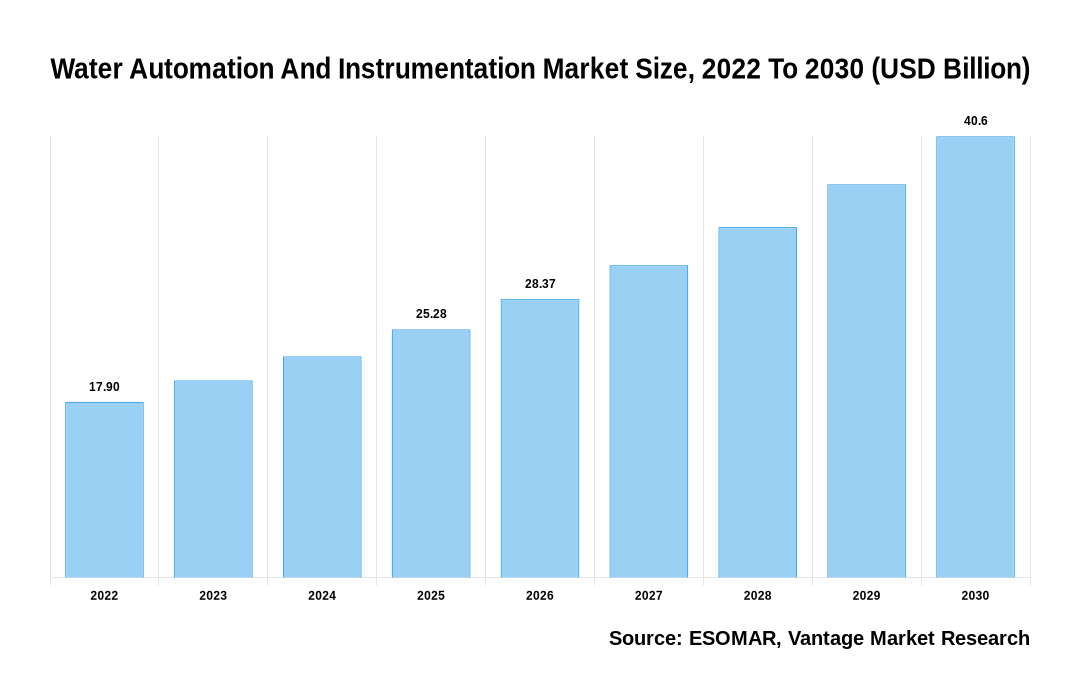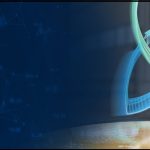Global Water Automation and Instrumentation Market
As stated in our extensive report, the Global Water Automation and Instrumentation Market accounted for USD 17.9 Billion in 2022 and is projected to reach a value of USD 40.6 Billion by 2030.
The Water Automation and Instrumentation market refer to the use of advanced control systems and various instruments to monitor and control water-related processes in industries such as wastewater treatment, desalination plants, water supply, and irrigation systems. It is a rapidly growing market due to the increasing need for efficient water management and the adoption of automation technologies in various industries.
The Water Automation and Instrumentation market is witnessing significant growth, with several key players offering a wide range of automation solutions and instruments. These solutions include SCADA (Supervisory Control and Data Acquisition) systems, flow meters, level sensors, water quality analyzers, pressure transmitters, and control valves.
Click To Get a Free Sample On the Research Study

In addition, the growth of the Water Automation and Instrumentation market is driven by the increasing need for efficient water management, strict government regulations, technological advancements, and the growing demand for water and wastewater treatment. The adoption of these systems helps industries and water utilities in optimizing their operations, reducing costs, and ensuring sustainable water management.
Key factors influencing Water Automation and Instrumentation Market Growth
The growth of the global Water Automation and Instrumentation market can be attributable to the following:
- With the rapidly growing global population and industrialization, water scarcity has become a significant concern. Governments and industries are recognizing the need to efficiently manage water resources, driving the adoption of automation and instrumentation technologies.
- Governments worldwide have implemented strict regulations to ensure the efficient use and conservation of water resources. These regulations encourage industries to invest in advanced automation and instrumentation systems to monitor and control their water usage, treatment processes, and compliance with environmental standards.
- The growing population and industrial activities increase the demand for clean water and the need for effective wastewater treatment. Water Automation and Instrumentation systems enable efficient management of water treatment processes, such as filtration, disinfection, and chemical dosing, to ensure the supply of safe and clean water.
- Advancements in automation and instrumentation technologies, such as IoT (Internet of Things), cloud computing, and artificial intelligence, have greatly contributed to the growth of the Water Automation and Instrumentation market. These technologies enable real-time monitoring, predictive maintenance, and remote control of water-related processes, improving operational efficiency and reducing costs.
- Water utilities and industrial facilities are increasingly adopting asset management strategies to optimize their water infrastructure and reduce operational and maintenance costs. Automation and instrumentation systems provide real-time data on asset performance, enabling proactive maintenance and optimizing asset utilization.
North America Region to Lead the Market
North America Water Automation and Instrumentation market is getting more notable, with the highest market sales during the forecast period. With increasing population and urbanization, the demand for water has been on the rise. However, water scarcity has become a major concern in many regions, particularly in arid areas such as western parts of the United States and parts of Canada. This has led to a greater emphasis on water conservation and efficient water management practices. As a result, there has been a growing adoption of automation and instrumentation technologies in the water industry. These technologies enable utilities to monitor and control various aspects of water distribution systems, such as water quality, flow rates, pressure levels, and leak detection. By using advanced sensors, meters, and controllers, utilities can optimize the use of water resources, reduce water losses, and improve overall operational efficiency.
Conclusion
The overall Water Automation and Instrumentation Market sales have been favorably impacted by growing awareness of the importance of water quality and the need for accurate water monitoring and testing, advancements in technology, rising industrialization and urbanization, and the emergence of the Internet of Things (IoT).
The well-known players of the Global Water Automation and Instrumentation Market include ABB Ltd. (Switzerland), Emerson Electric Co. (U.S.), General Electric Company (U.S.), Mitsubishi Electric Corporation (Japan), Schneider Electric SE (France), Siemens AG (Germany) and others.
![[Market Research Reports] – Research Google News Blog | VMR.Biz](https://www.vmr.biz/wp-content/uploads/2022/12/logo-removebg-preview.png)











